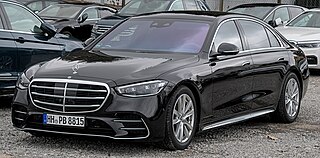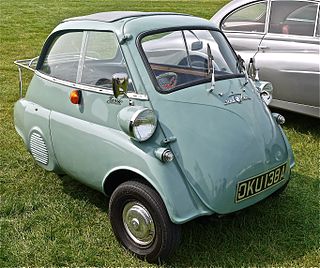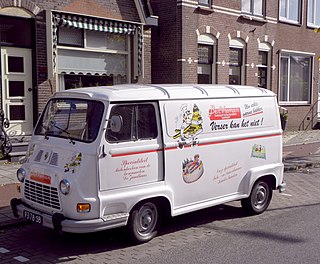
The Volkswagen Beetle—officially the Volkswagen Type 1, informally in German der Käfer, in parts of the English-speaking world the Bug, and known by many other nicknames in other languages—is a two-door, rear-engine economy car, intended for five occupants, that was manufactured and marketed by German automaker Volkswagen (VW) from 1938 until 2003.

The Ford Country Squire is a series of station wagons that was assembled by American automaker Ford. The premium station wagon of the Ford division, the Country Squire was distinguished by its external woodgrain trim. From the 1950 to 1991 model years, eight generations of the Country Squire were produced. Following the discontinuation of Edsel, Mercury marketed the Mercury Colony Park as a divisional counterpart of the Country Squire, sharing bodywork and trim.

The Mercedes-Benz S-Class, formerly known as Sonderklasse, is a series of full-size luxury sedans, limousines and armored sedans produced by the German automaker Mercedes-Benz, a division of German company Daimler AG. The S-Class is the designation for top-of-the-line Mercedes-Benz models and was officially introduced in 1972 with the W116, and has remained in use ever since. The S-Class is the flagship vehicle for Mercedes-Benz.

The Isetta is an Italian-designed microcar built under license in a number of different countries, including Argentina, Spain, Belgium, France, Brazil, Germany, and the United Kingdom. Because of its egg shape and bubble-like windows, it became known as a bubble car, a name also given to other similar vehicles.

The Mercedes-Benz 300 SL is a two-seat sports car that was produced by Mercedes-Benz as a gullwinged coupe (1954–1957) and roadster (1957–1963). It was based on the company's 1952 racer, the W194, with mechanical direct fuel-injection which boosted power almost 50% on its 3-liter overhead camshaft straight-6 engine. Capable of reaching a top speed of up to 263 km/h (163 mph), it was both a sports car racing champion and the fastest production car of its time.

Gutbrod was a German manufacturer of cars, motorcycles and small agricultural machinery. The firm was founded in Ludwigsburg, Germany by Wilhelm Gutbrod in 1926. It originally built "Standard" branded motorcycles. In 1933 the company relocated to the nearby Stuttgart suburb of Feuerbach, and from 1933 to 1935, Standard Superior cars were built with rear-mounted engines.

The Morris Minor is a British economy family car that made its debut at the Earls Court Motor Show, London, on 20 September 1948. Designed under the leadership of Alec Issigonis, more than 1.6 million were manufactured between 1948 and 1972 in three series: the MM, the Series II, and the 1000 series.

The Peugeot 203 is a small family car which was produced by the French car manufacturer Peugeot between 1948 and 1960.

The Rover P4 series is a group of mid-size luxury saloon cars produced by the Rover Company from 1949 until 1964. They were designed by Gordon Bashford.

The Renault Estafette is a light commercial front-wheel drive van, first introduced in 1959 and made by the French automaker Renault between 1959 and 1980, initially using the water-cooled Renault Ventoux engine, then later the Cléon-Fonte engine in a range of body styles. It was replaced by the Renault Trafic.
Goliath-Werke Borgward & Co. was a German car manufacturer started by Carl F. W. Borgward and Wilhelm Tecklenborg in 1928, and was part of the Borgward group. Goliath was based in Bremen and specialized in three-wheeler cars and trucks and medium-sized cars. Their vehicles were sold under the Goliath brand.

The Mercedes-Benz W136 was Mercedes-Benz's line of inline-four cylinder motorcars from the mid-1930s into the 1950s. The model 170 V made its public debut as successor to the W15 Typ 170 in February 1936. Between 1936 and 1939 it was Mercedes' top selling model.

The Standard Vanguard is a car which was produced by the Standard Motor Company in Coventry, England, from 1947 to 1963.
The SA was Toyota's first new passenger car design after World War II. It was the first in a family of vehicles before the introduction of the Crown. A series of light trucks also shared the chassis and major components of these passenger cars.

Fuldamobil is the name of a series of small cars produced by Elektromaschinenbau Fulda GmbH of Fulda, Germany, and Nordwestdeutscher Fahrzeugbau (NWF) of Wilhelmshaven between 1950 and 1969. Various designated versions of the car were produced, although the vehicles produced under each designation were not always identical and the designations were sometimes misapplied. Though overall numbers produced were relatively small, the cars attracted sufficient attention to see licensed construction on four continents including Europe. In its ultimate configuration it is said to have inspired the term "bubble car". It is acknowledged as the first car in the world to feature a negative scrub radius, now recognised as a major advance in driving safety.

The Borgward Hansa 1500 is a medium-sized automobile that was manufactured by the Bremen based auto-manufacturer Carl F. W. Borgward GmbH from 1949 to 1954. It was first presented at the Geneva Motor Show in March 1949 and production commenced on 13 October 1949. The similar Hansa 1800 was introduced in 1952. The Hansa was replaced by the Borgward Isabella in 1954.

The Opel Olympia Rekord was a two-door family car that replaced the Opel Olympia in March 1953. Innovations included the strikingly modern Ponton format body-work incorporating numerous styling features from the United States and large amounts of chrome decoration both on the outside and on the inside.

The Lloyd 600 was a small car produced by the Borgward Groups's Lloyd Motoren Werke GmbH in Bremen between 1955 and 1961.
The Goliath GV800 was a light freight truck built in the early 1950s in Bremen, Germany. It also was available as panel van and reached up to 37 mph. It was announced in March 1951.

The Gutbrod Superior was a small car, built from 1950 to 1954 by German manufacturer Gutbrod. A total of 6860 cabriolet saloons and 866 estates were built in less than four years.
















